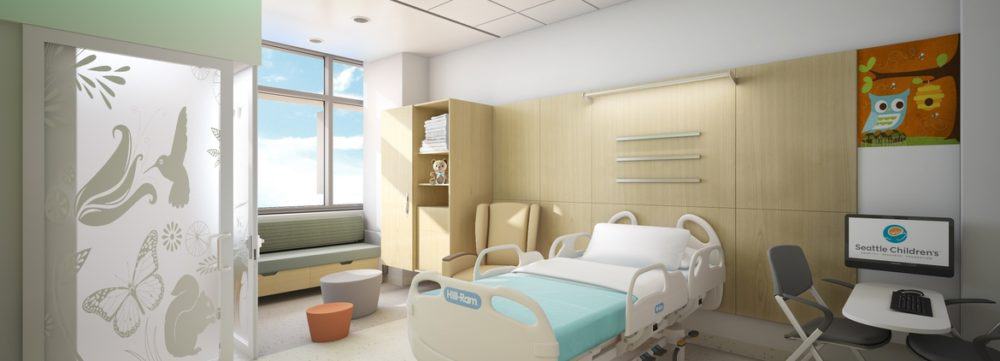Blog
Win-Win: Incorporating Lean Design Can Slash Operating Costs and Improve Patient Safety, Family and Staff Satisfaction

Going the extra mile to incorporate the principles of Lean design into the construction process is a win-win. The outcome is slashed operating costs and improved outcomes for patients, their family, and staff.
In 2012 Seattle Children’s Hospital prepared for a new, multimillion-dollar patient care building by incorporating the lean process. The outcome? Slashed operation costs and high ratings of patient and staff satisfaction. In Fact, Seattle Children’s Hospital was recently named in the top ten Best Hospitals in the US.
Case Study: Seattle Children’s Hospital
In 2012, plans for construction were laid out based on research, data and careful planning. Data was gathered from doctors, nurses, patients, family members, other caregivers, support services staff, the designers, and builders.
The following year, the new nine-story, 330,000-SF facility, named Building Hope, opened. The building had an emergency department and 80 private patient rooms.
Project Goals
The project goals were based on the guiding principles of providing quality patient care, family and staff comfort, a safe environment, affordable services, and flexible spaces, as well as being a good neighbor, employing uniform design concepts, and incorporating elements of sustainability.
The Lean Process
Conducting mockups of patient rooms at key stages during the Lean design process provided a forum to simulate work and process improvements. The mockups create a full-scale “living laboratory” where many hypotheses to simultaneously improve workflow and space may be tested, proven, and ultimately improved.
The objectives of the mockups were to observe the current state at the site of care; propose seven ways to make improvements; simulate, test, and evaluate the potential improvements; and then identify standards of work. Participants included patients, family members, nurses, physicians, pharmacists, housekeepers, materials managers, dietitians, infection control specialists, engineers, architects, contractors, and hospital leaders.
“Challenges and surprises were encountered at almost every step, mostly minor challenges related to pushing people beyond their comfort zone to foster problem solving and innovation to yield improvement,” says Mark Gesinger, a senior medical designer at ZGF Architects in Seattle. “Proposals and ideas that seemed workable in concept impacted other members of the care team in unexpected ways.”
For example, the care team envisioned a completely open core on the bed unit. However, after running a code blue simulation, it was discovered that the impulse of everyone in a patient room or elsewhere on the unit was to see what was happening. The design was changed to provide partitions and glass around key spaces in the core to minimize the view from patient room to patient room to ensure a degree of dignity and a sense of privacy.
Empowering the individuals who work in the facility to recommend improvements ensures the suggestions will be user-friendly and creates substantial buy-in. More than 20 planning events were conducted with hundreds of users investing tens of thousands of hours – the equivalent of more than 20 people working full-time for over a year.
Design Results
The mockups were critical to creating a final building design that supports the needs of all stakeholders who were involved in the planning process. The ultimate goal is to provide quality care to patients and a comfortable environment for their families by making operations run smoothly and safely for physicians and nurses. Every detail, including the provision of natural daylighting and views to the outside landscaping, are addressed.
The design is based on the outcomes of the mockups, which enabled stakeholders to simulate important workflow processes and then determine whether improvements were necessary. The simulations and subsequent recommendations form the basis for the design.
Design Pays Off
The U.S. News Best Hospitals analysis reviews hospitals’ performance in pediatric clinical specialties, procedures and conditions. Scores are based on several factors, including survival, patient safety, nurse staffing and more. Hospitals are ranked nationally in specialties and rated in common procedures and condition. Hospitals are also ranked regionally within states and major metro areas. The Best Children’s Hospital Honor Roll recognizes 10 hospitals with superior pediatric care.
Seattle Children’s Hospital was recently awarded two distinctions. They were ranked in the Top Ten for Children’s Specialties and Add to the top ten on the U.S. News Best Children’s Hospitals Honor Roll.
Incorporating Lean design techniques in the construction phase pays off. Proper planning and preparation help designers obtain real-time analysis of the workflows needed out of the space. Creating project mockups help stakeholders imagine potential challenges that could occur in the real-world health care industry and create the most optimal solutions. The outcome is a win-win as it creates a more efficient environment that works better for everyone.
Marie Wikoff is the creator of Wikoff Design Studio based out of Reno, Nevada. Her expertise in healthcare design has helped modernize healthcare organizations locally, regionally, and internationally, improving patient experience and outcomes. Her credentials include Evidence-Based Design Accreditation and Certification (EDAC), American Academy of Healthcare Interior Designer (CHID), the National Council of Interior Design Qualification (NCIDQ) and LEED AP. Contact Marie Wikoff
Sources:
Tracy Carbasho. “Lean Design Process Prepares Seattle Children’s Hospital for Tomorrow.” Tradeline, Inc., ZGF Architects LLP, 20 July 2018, www.tradelineinc.com/reports/2012-7/lean-design-process-prepares-seattle-childrens-hospital-tomorrow.
“Rankings & Ratings at Seattle Children’s Hospital.” U.S. News & World Report, U.S. News & World Report, health.usnews.com/best-hospitals/area/wa/seattle-childrens-hospital-6910560#rankings.
Photo Credit: Photo provided by ZGF Architects







